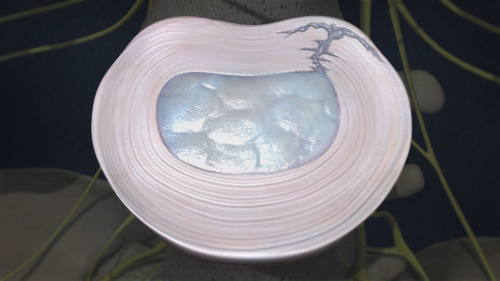WHAT IS DEGENERATIVE DISC DISEASE
Discs are shock absorbers. They sit between bones that are connected by facet joints, but they don’t provide much strength. Walking, running, and bouncing create stress and strain on the spine. The discs absorb those forces, protecting the nerve roots and spinal cord. Over time millions of small stresses and strains begin to add up. Eventually, the discs develop tears, become dry, get shorter, and just plain wear out. As the body tries to heal the tears in the discs, nerve fibers that send pain signals sometimes grow into the disc. This can result in a disc that feels like a knife in the back every time you stand. Normal changes in the disc that occur due to the forces of everyday life are called degenerative changes. If these changes occur across several discs, or prematurely, they’re referred to as degenerative disc disease. For most of us, though, it’s not a disease like diabetes; it’s really just part of aging.
SYMPTOMS OF DEGENERATIVE DISC DISEASE
Degenerative disc disease causes low back pain in two different ways. First, the nerve roots can be pinched as a direct result of degenerative disc disease. A nerve root exits the spinal canal through a small hole called the foramen. The height of the foramen is determined, to a great degree, by the height of the disc. When discs degenerate, they lose height. As a result, when discs degenerate, the foramen loses height. If the space for the nerve root in the foramen gets tight enough the nerve root and become pinched and painful. When this occurs you feel leg pain more than back pain.
Degenerative disc disease can also cause back pain itself. The reason is a little bit complicated. The disc is composed of two parts: a very tough outer part, and an inner gel. Because the inner part of the disc is made out of a gel, it does not have its own blood supply. (Fun fact, the disc is the largest structure in the human body that does not have its own blood supply.) The way your body knows what is part of you, and when his not part of you, is through the blood supply. As a result, if you have a tear in the disc, the inner part is exposed to the rest of the body.
It sounds strange, but your body really doesn’t realize the disc is part of you. If you’ve ever had a sliver stuck in your skin you know what happens next. The result is a strong inflammatory response. The tear in a disk can feel like a knife in your back because to your body, there is a knife finger back. Left alone, all of this inflammation ultimately reabsorbs the disc, and her body would cause a fusion across the disc space made out of bone.
In the meantime, pain fibers accompany the healing reaction actually grow into the disc. Activation of these pain fibers just by standing up every day creates severe back pain. In addition, the inflammation spills into the epidural space causing epidural irritation. If you put numbing medicine in the epidural space you can temporarily relieve pain; if you put inflammation in the epidural space it causes pain.
CAUSES OF DEGENERATIVE DISC DISEASE
Life. Degeneration is normal. No one was designed to live to be over 40. If you were hit by a bus at age 20 you would have very little degenerative disc disease. Some people are clearly more prone to it than others. Doctors don’t know the exact gene, but bad discs run in the family.
TREATMENTS FOR DEGENERATIVE DISC DISEASE
The best way to handle degenerative disease is to build core strength. You may have inherited your discs, but you can sure build lots of strong muscle around them to help absorb the stress and strain. Losing weight helps, too. A brace may be useful once in a while to support the spine in high stress activities. Tylenol, Aleve, and ibuprofen help too. In really severe cases the whole disc needs to be removed surgically. That usually involves a fusion to replace the missing disc.
APPROACH TO DEGENERATIVE DISC DISEASE
If the degenerative disc is the source of your low back pain, then the only way to eliminate the pain is to eliminate the disc. In an outpatient surgery center, they remove painful discs using a minimal access approach. Looking down a microscope through a 1 inch incision they incise the disc, and remove it entirely. Something has to replace the disc, otherwise the vertebral bones with collapse.
They will often use an implant from Titan Spine to maintain the disc height. The implant is made out of plastic but has a nano-technology coating made out of titanium which allows your bones to connect directly with the implant. Surgery takes around 60 min, and you can go home afterward.
As a result of the minimal access techniques, most patients are 50% recovered from the surgery in one week, and completely recovered by three weeks. The implant heals to the bone over 6-12 weeks. Ultimately your body grows bone through the former disc space entirely, causing a solid fusion in 6-12 months.





 Subscribe!
Subscribe!




